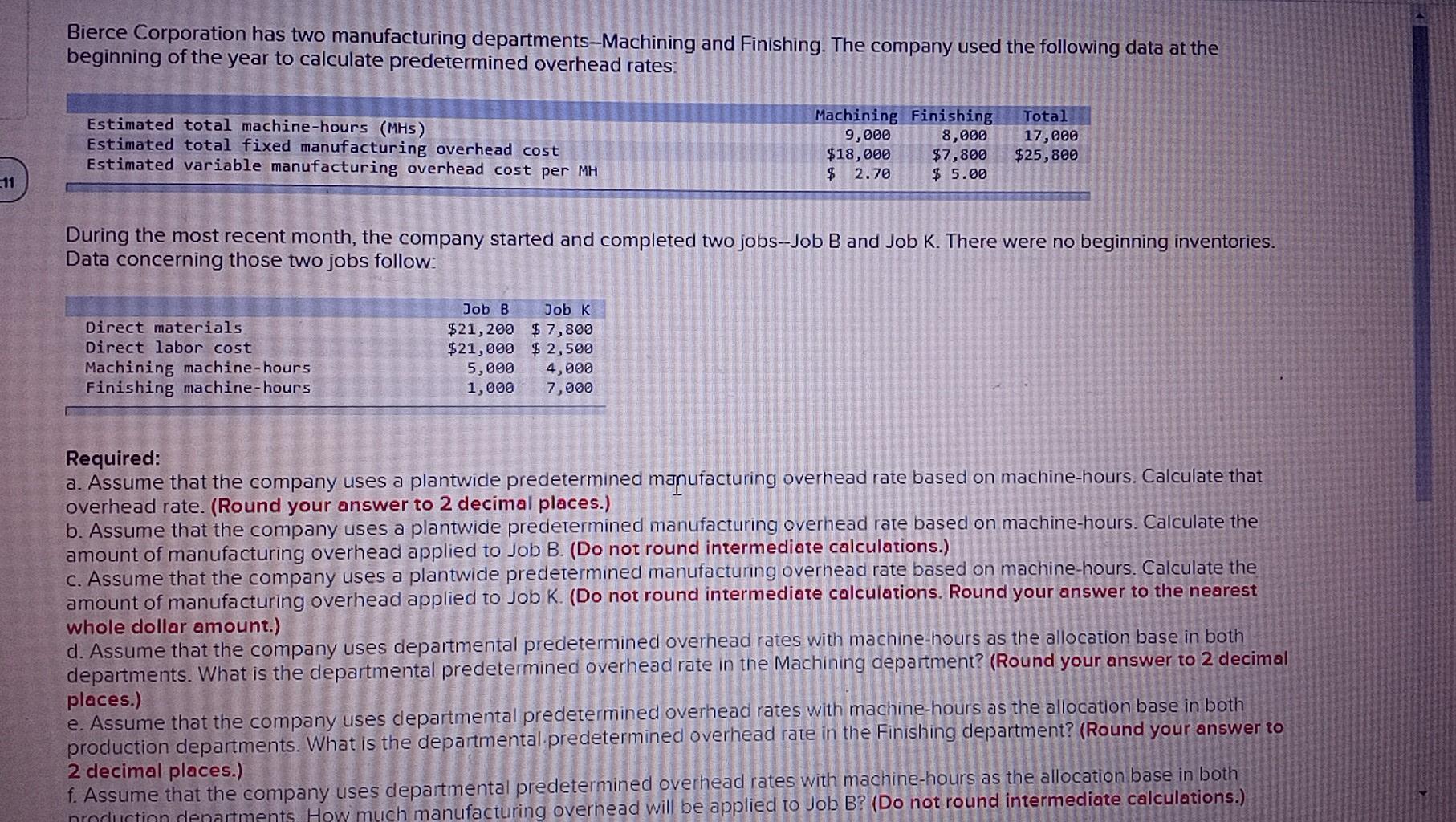Answered step by step
Verified Expert Solution
Question
1 Approved Answer
Bierce Corporation has two manufacturing departments-Machining and Finishing. The company used the following data at the beginning of the year to calculate predetermined overhead rates:


Bierce Corporation has two manufacturing departments-Machining and Finishing. The company used the following data at the beginning of the year to calculate predetermined overhead rates: Estimated total machine-hours (MHS) Estimated total fixed manufacturing overhead cost Estimated variable manufacturing overhead cost per MH Machining Finishing 9,000 8,000 $18,000 $7,800 $ 2.70 $ 5.00 Total 17,000 $25,800 11 During the most recent month, the company started and completed two jobs-Job B and Job K. There were no beginning inventories. Data concerning those two jobs follow: Direct materials Direct labor cost Machining machine-hours Finishing machine-hours Job B Job K $21,200 $ 7,800 $21,000 $2,500 5,000 4,000 1,000 7,000 Required: a. Assume that the company uses a plantwide predetermined manufacturing overhead rate based on machine-hours. Calculate that overhead rate. (Round your answer to 2 decimal places.) b. Assume that the company uses a plantwide predetermined manufacturing overhead rate based on machine-hours. Calculate the amount of manufacturing overhead applied to Job B. (Do not round intermediate calculations.) C. Assume that the company uses a plantwide predetermined manufacturing overhead rate based on machine-hours. Calculate the amount of manufacturing overhead applied to Job K. (Do not round intermediate calculations. Round your answer to the nearest whole dollar amount.) d. Assume that the company uses departmental predetermined overhead rates with machine-hours as the allocation base in both departments. What is the departmental predetermined overhead rate in the Machining department? (Round your answer to 2 decimal places.) e. Assume that the company uses departmental predetermined overhead rates with machine-hours as the allocation base in both production departments. What is the departmental predetermined overhead rate in the Finishing department? (Round your answer to 2 decimal places.) f. Assume that the company uses departmental predetermined overhead rates with machine-hours as the allocation base in both nroduction denartments How much manufacturing overhead will be applied to Job B? (Do not round intermediate calculations.) ctoring Enabled: Quiz ch2 i Saved Help Save & Exit 2 01:14:51 a. Assume that the company uses a plantwide predetermined manufacturing overhead rate based on machine-hours. Calculate that overhead rate. (Round your answer to 2 decimal places.) b. Assume that the company uses a plantwide predetermined manufacturing overhead rate based on machine-hours. Calculate the amount of manufacturing overhead applied to Job B. (Do not round intermediate calculations.) C. Assume that the company uses a plantwide predetermined manufacturing overhead rate based on machine-hours. Calculate the amount of manufacturing overhead applied to Job K. (Do not round intermediate calculations. Round your answer to the nearest whole dollar amount.) d. Assume that the company uses departmental predetermined overhead rates with machine-hours as the allocation base in both departments. What is the departmental predetermined overhead rate in the Machining department? (Round your answer to 2 decimal places.) e. Assume that the company uses departmental predetermined overhead rates with machine-hours as the allocation base in both production departments. What is the departmental predetermined overhead rate in the Finishing department? (Round your answer to 2 decimal places.) f. Assume that the company uses departmental predetermined overhead rates with machine-hours as the ocation base in both production departments. How much manufacturing overhead will be applied to Job B? (Do not round intermediate calculations.) g. Assume that the company uses departmental predetermined overhead rates with machine-hours as the allocation base in both production departments. How much manufacturing overhead will be applied to Job K? (Do not round intermediate calculations.) a. Predetermined overhead rate per MH b d per MH Manufacturing overhead applied Job B Manufacturing overhead applied Job K Machining predetermined overhead rate Finishing predetermined overhead rate Manufacturing overhead applied Job B Manufacturing overhead applied job K per MH e f. g
Step by Step Solution
There are 3 Steps involved in it
Step: 1

Get Instant Access to Expert-Tailored Solutions
See step-by-step solutions with expert insights and AI powered tools for academic success
Step: 2

Step: 3

Ace Your Homework with AI
Get the answers you need in no time with our AI-driven, step-by-step assistance
Get Started


